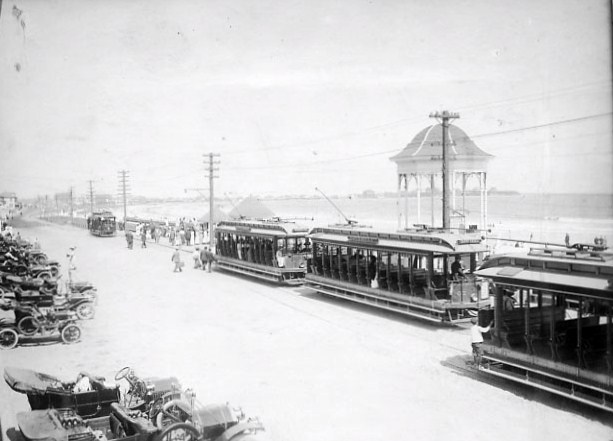By Horace E. Hobbs
“Letters To The Editor”
Hampton Union, Wednesday, April 28, 1976

[Photo was not in original Letter to the Editor.]
(Photo courtesy O. R. Cummings)
To the Editor:
I was born in Hampton in 1899 and have memories of “Growing Up in Hampton”. This is the name of some of the incidents which I am recording. Pleasant are the memories of “Happy Hampton.”
It was nearly 60 years ago that I first went railroading for the Exeter, Hampton and Amesbury Street Railway. My uncle, Walter Scott, was superintendent and he gave me a job as conductor, summers while I was going to college.
With guarded memory, I recall some of the “regular” men who made the railroad go. First of all was my Uncle Walter (Scott) whom I admired and respected. He was a man of extremely good nature and liked by all. Tall and a man of robust stature I can well remember the ease and grace that was always his as he alighted from the rear platform of a moving trolley.
Next to him was Lewis Clark who was the “starter” at Whittier’s Corner. His little dispatch house painted green and the object of many a fourth of July prank, sat at the junction of the car lines as they left for the beach, Exeter, and Smithtown to connect with the Northeastern Street RR for Newburyport, Amesbury, and Haverhill. With his style and dashing blue uniform he must have made quite a hit, for eventually he did marry the nearby maiden, Mary Toppan.
By this action, Lew was able to move from his little green shack to Mary’s pretentious white home nearby and everyone was happy.
Next on the list was Frank Stevens. Frank was starter at the beach during the summer and was master of all be surveyed. He had a comely daughter, Adeline, who was a favorite with the boys. Her graces and Frank’s efforts made her one of the first carnival queens at Hampton Beach.
Other regulars were two veteran motormen, George Munsey and Howard Lane. There was always Howard (driving No. 10) and George No. 12 or 14. These were small closed cars used in the winter and had a coal stove, a smoke stack coming through the top of the car and had a load of coal in the rear. It was the conductor’s job to tend the fire and keep the car warm.
All these cars just had hand brakes that wound up with a crankshaft. On the other cars in the summer I can see Howard standing out front and struggling madly to wind up the hand brake. George was much heavier than Howard and seemed to be able to sit on his stool and work his brake calmly and without exertion. Dire was the day in history of railroading when these two “old pros” met head on in their open cars at DeLancey’s curve opposite where Lantern Lane is now located. I lived nearby and rushed out at the sound of the crash.
There was George still sitting dazed and calm on his stool but active Howard was out walking around viewing the damage from the 15-mile an hour crash. Someone had goofed!
Other motormen of note in my day were:
Bert Brown with whom I used to run the night shift at North Beach siding up by the Casino. Most fun came with a carload of sailors from the Portsmouth Navy Shipyard.
Arthur Young worked mostly summers on the big eight wheelers 61, 63, 65, 67. These were large air brake open cars with seats for about 80-100 passengers. Arthur could really “send” them. Herbert Lamprey worked regularly and was no mean man at the controls.
Famous for his stories, told in his own stammering way was “Spit” Willey. I wish that I could remember his real name. He was a motorman but was not in competition with Howard Lane who was an inveterate tobacco chewer and insisted on spitting into the wind. He apparently didn’t care about himself but the young girls who wanted the thrill of riding “up front” got more than they bargained for on their pretty summer dresses as Howard expectorated “over the dash”.
Of course there were the other lesser breed of conductors like myself. Our pay was 17 cents per hour. But there was a stalwart like James Eastman who stayed on until the demise of the railroad [1926] and then some.
Those were the days!